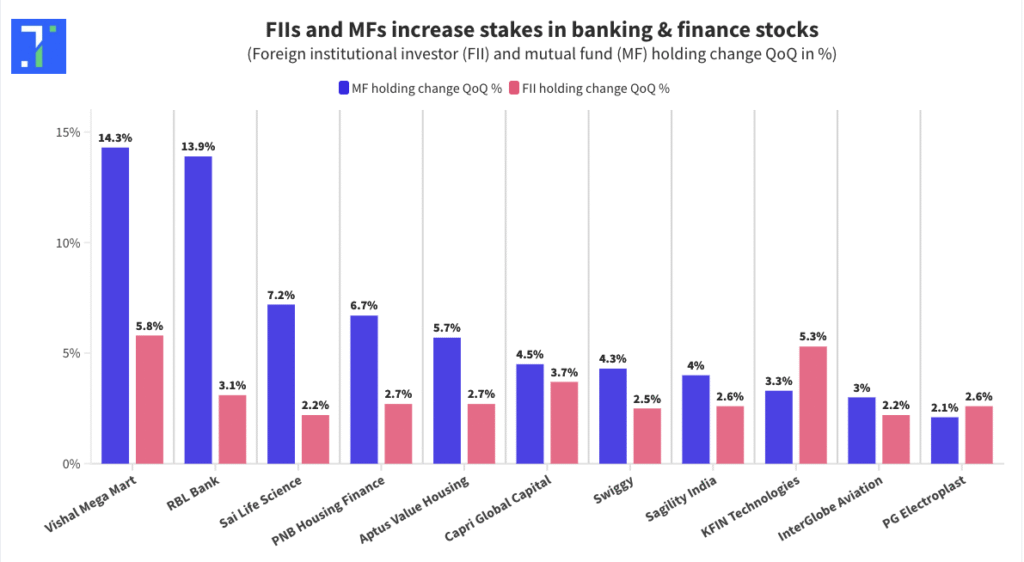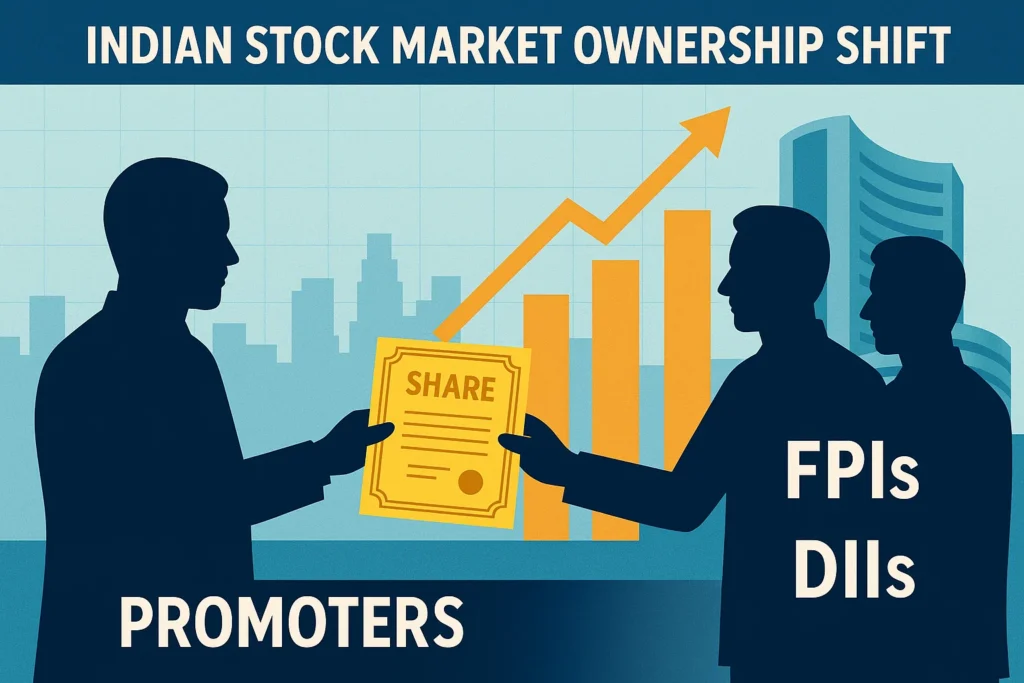Introduction
In India’s equity markets, ownership tells a story. Who holds the shares—promoters, foreign institutional investors (FIIs), or domestic mutual funds (MFs)—can reveal a lot about where a company might be headed.
Q1FY26 was one of those rare quarters when that story took an unexpected turn. A wave of promoter stake sales—often through large block deals—opened the door for institutional giants to step in. And step in they did, triggering what could be called a “smart money reshuffle” in several major companies.
It wasn’t just about FIIs and MFs buying; it was about who they were buying from and why they chose this quarter to do it.
Why This Quarter Was Different
To understand the promoter stake sales and institutional shift in Q1FY26, you need to zoom out.
- FIIs have been selective in 2025. They’ve cut exposure in some sectors but doubled down in others—particularly financials, telecom, and services.
- MFs, flush with SIP inflows and cash from redemptions elsewhere, were ready to pounce when the right opportunities appeared.
- Promoters—whether due to regulatory lock-in expiries, private equity exits, or capital reallocation—offloaded meaningful stakes, often in high-quality companies.
This created a perfect storm: liquidity windows that matched institutional appetite.
“When the right stock meets the right liquidity event, institutions don’t just dip their toes—they dive in.”
Theme 1 — Promoter Stake Sales Unlock Institutional Buying
Promoter stake sales were the single biggest catalyst for the ownership reshuffle in Q1FY26. They provided the supply of shares that institutions need to take large positions without moving the market too much.
Let’s look at the most striking examples.
Vishal Mega Mart — Bharat’s Retail Powerhouse
| Detail | Data |
|---|---|
| Promoter Stake Sale | 20% (₹10,488 crore) by Samayat Services LLP in June |
| FII Change QoQ | +14.3% |
| MF Change QoQ | +5.8% |
| FY25 Revenue Growth | +20.5% |
| FY25 Net Profit Growth | +36.8% |
This wasn’t just a stake sale—it was a changing of the guard. The block deal happened right after the pre-IPO lock-in expired, and the buyers were a who’s who of domestic fund houses: HDFC Business Cycle Fund, SBI Equity Hybrid Fund, Kotak Pioneer Fund.
Why did they jump in? Because Vishal Mega Mart’s business model is tailor-made for India’s consumption story—strong presence in tier-2 cities, 73% of revenue from private labels (higher margins), and efficient operations.
PG Electroplast — Quietly Becoming a Manufacturing Leader
| Detail | Data |
|---|---|
| Promoter Stake Sale | 5.6% (₹1,177 crore) in May |
| FII Change QoQ | +2.1% |
| MF Change QoQ | +2.6% |
| FY25 Revenue Growth | +77.7% |
| FY25 Net Profit Growth | +113.3% |
PG Electroplast has been riding India’s domestic manufacturing push. From air conditioners to washing machines, demand is strong, and their backward integration has boosted profitability.
Institutions like the Government of Singapore and ICICI Prudential Smallcap Index Fund saw this as an opportunity to buy a growth story that’s also aligned with the “Make in India” theme.
Theme 2 — Sector Shifts in Ownership
While retail and manufacturing had their moments, financial services stole the spotlight in Q1FY26’s promoter stake sales and institutional shift.
Five financial companies saw a significant transfer of ownership from promoters or private equity to FIIs and MFs. Here’s why:
- Housing finance is booming again, thanks to falling NPAs and rising middle-class demand.
- Mid-tier banks are back in favour, with better asset quality and stable credit growth.
- Asset managers are tapping global growth.
The Financials That Caught Institutional Eyes
| Company | Trigger | FII Change | MF Change | Notes |
|---|---|---|---|---|
| KFIN Technologies | 10% stake sale by General Atlantic | +5.3% | +3.3% | Global expansion via Singapore deal |
| PNB Housing Finance | Carlyle exits 10.4% | +2.7% | +6.7% | Strong housing demand |
| Aptus Value Housing | Westbridge exits 12.6% | +2.7% | +5.7% | Affordable housing growth |
| RBL Bank | British International Investment exit | +3.1% | +13.9% | Asset quality rebound |
| Capri Global Capital | ₹2,000 crore QIP | +3.7% | +4.5% | First QIP in 10 years |
The standout here is RBL Bank—not just because MFs increased their stake by an eye-popping 13.9%, but because it signals renewed confidence in mid-tier banks, which were out of favour just a year ago.
Theme 3 — New Listings Becoming Institutionally Owned
The promoter stake sales and institutional shift Q1FY26 story isn’t just about old names. Some of the newest players on the exchange are already seeing institutions muscle in.
These companies went public in late 2024 and have since proved they can deliver.
Sai Life Sciences
- MF Change: +7.2%
- FII Change: +2.2%
- Why: Strong FY25 performance (revenue +15.9%, net profit +105.5%), leadership in CDMO & CRO segments.
Swiggy
- MF Change: +4.3%
- FII Change: +2.5%
- Why: Revenue up 34.3%, strategic shift in quick commerce to inventory-led model for better margins.
Sagility India
- MF Change: +4%
- FII Change: +2.6%
- Why: Net profit growth of 136.2%, operational efficiency gains post-IPO.

What This Means for Retail Investors
The promoter stake sales and institutional shift Q1FY26 carries some important lessons:
1. Follow the Ownership Trail
When both FIIs and MFs step in after a promoter exits, it’s often a signal that they see long-term potential.
2. Promoter Exits Aren’t Always Bad News
In the right context—like strong earnings and expansion plans—it can actually be the start of a new growth phase.
3. Liquidity Windows Create Opportunity
Block deals and QIPs give institutions the chance to buy big without moving the market too much.
Quick Checklist for Spotting the Next Shift
- Is there a large promoter stake sale announced?
- Are the buyers credible institutions?
- Does the company have recent earnings beats?
- Is the sector in an uptrend?
Conclusion — The Changing Face of Indian Corporate Control
The promoter stake sales and institutional shift Q1FY26 wasn’t a one-off. It’s part of a larger trend where ownership in India’s leading companies is gradually moving from founders and early investors to professional, long-term institutional capital.
This shift could change not just stock price trajectories, but also corporate governance, growth priorities, and risk appetite in the years ahead.
For retail investors, the takeaway is simple:
“If you can spot the ownership change early, you can ride the same wave the smart money is surfing.”
Q2FY26 will likely bring new stake sales, more block deals, and perhaps another list of companies where institutional hands are tightening their grip. The question is—will you be watching closely enough to catch the next move?
FAQs: promoter stake sales and institutional shift:
1. What does promoter stake sale mean?
A promoter stake sale refers to company promoters reducing their shareholding by selling part of their ownership to other investors, which could include institutions, retail investors, or strategic partners.
2. Why do promoters sell their stake in a company?
Promoters may sell stakes for reasons like funding new ventures, personal liquidity needs, debt repayment, or to bring in professional management and institutional investors.
3. What is an institutional shift in the stock market?
An institutional shift happens when ownership in listed companies moves from promoters to institutional investors such as mutual funds, insurance companies, pension funds, and foreign portfolio investors (FPIs).
4. How do promoter stake sales impact stock prices?
Stake sales can affect stock prices depending on market perception. If sales are for strategic reasons, prices may remain stable or rise. However, unexpected large sales can cause short-term volatility.
5. What role do FPIs play in institutional shift?
Foreign Portfolio Investors (FPIs) bring global capital to Indian markets, often buying promoter stakes in quality companies. Their investments can influence market liquidity and valuations.
6. How do DIIs contribute to the institutional shift?
Domestic Institutional Investors (DIIs), such as mutual funds and insurance firms, have increased their share in Indian equities due to strong inflows from retail investors and long-term investment mandates.
7. Is promoter stake dilution always negative?
No. While it may reduce promoter control, stake dilution can improve corporate governance, increase liquidity, and attract long-term institutional capital.
More Articles
Best Stock Broker in India: How to Choose Best Broker in 2025
The 15-15-15 Rule: Why the ₹1 Crore SIP Dream Needs a Reality Check
Gold vs Silver vs Sensex: Who Made You Richer?






